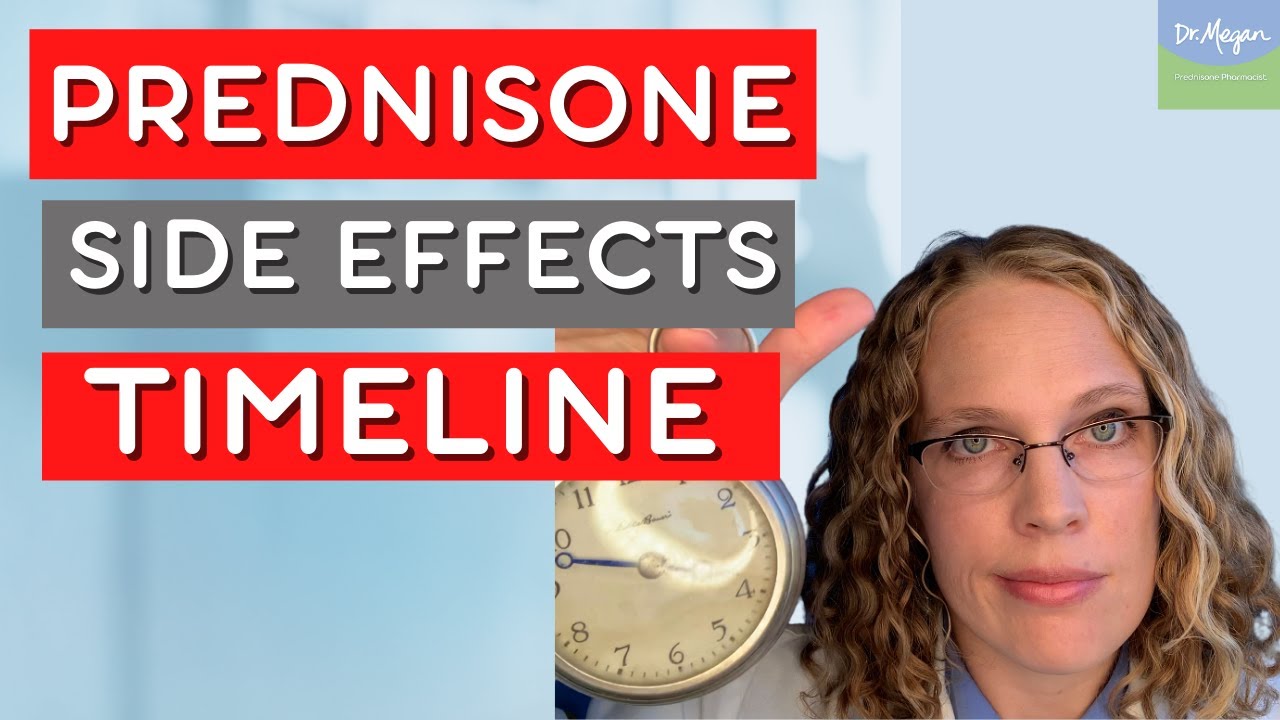Understanding prednisone side effects in women is crucial for anyone taking this medication. It’s often prescribed for a range of conditions like autoimmune disorders and allergies, and while it can provide significant relief, its side effects could impact your quality of life. Many women benefit from its anti-inflammatory properties, so being educated about these potential pitfalls can make a big difference in your overall well-being.
When you embark on your journey with prednisone, think of it like a workout—knowledge is your best trainer! You wouldn’t go lifting weights without knowing the right form, right? So, let’s dive into some notable side effects of prednisone, ensuring you’re prepared and empowered.

Top 7 Prednisone Side Effects in Women You Must Know
A major concern with prednisone is weight gain, which many women experience. Research published in the Journal of Clinical Endocrinology & Metabolism showed that women on prednisone typically gain between 10 to 30 pounds in just the first few months. This weight often accumulates around the belly, leading to increased body fat and changing your physique. When you’re trying to get shredded with ripped six-packs, this could throw a wrench in your plans!
Another significant side effect are mood swings. Women on prednisone often report increased anxiety and depression. Reports indicate that about 30% of women experience mood swings severe enough to require intervention. It’s essential to understand the connection between prednisone and hormonal fluctuations, as these swings can make day-to-day life a challenge.
Long-term use of prednisone leads to decreased bone density, putting women at a higher risk for osteoporosis. According to the National Osteoporosis Foundation, women on chronic prednisone therapy have a tripled risk of hip fractures. That’s serious business! Being aware of this risk can help you take preventive measures, like engaging in weight-bearing exercises to strengthen those bones.
Keep an eye on your cycles, ladies! Prednisone can mess with your menstrual patterns, leading to irregular periods or even amenorrhea (the absence of periods). Clinicians have noted these changes in many women, especially those already dealing with hormonal fluctuations. If your cycles go off the rails, talk to your doctor to explore your options.
Watch out for stomach issues! Women taking prednisone often face gastrointestinal problems, including stomach pain, indigestion, and sometimes even ulcers. If you combine prednisone with non-steroidal anti-inflammatory drugs (NSAIDs) like aspirin, these problems can worsen. It’s essential to keep track of your diet and consult a healthcare professional if you experience discomfort.
Ladies, your skin deserves some TLC. On prednisone, women can experience problems like easy bruising, acne, and skin thinning. These side effects can hit hard on self-esteem, especially for younger women. Knowing this ahead of time allows you to prepare or even take preventive actions, keeping your skin looking sharp during treatment.
Always be cautious about mixing medications! Prednisone can interact with several other drugs. For instance, combining it with paroxetine, an antidepressant, can increase mood alteration side effects. Likewise, pairing prednisone with Tylenol might lead to liver complications. Before any combination, have a chat with your healthcare provider to steer clear of unwanted interactions.

Addressing Effects of Prednisone: A Broader Perspective
Understanding prednisone side effects in women isn’t just about the drug itself; it’s also about other medications you may be taking. For instance, women undergoing treatment with tamoxifen, often prescribed for breast cancer, may find their mood disorders worsened in conjunction with corticosteroids like prednisone. This interconnectedness shows the importance of looking at your entire treatment plan, ensuring that each component works in harmony with the others.
Moreover, if you’re on progesterone supplementation, you might discover that it either alleviates or exacerbates certain side effects linked to prednisone. Research indicates that hormone replacement therapy can balance or amplify psychological effects among women, further complicating the situation. Staying educated about what’s happening in your body can be the key to effective treatment.

Navigating Your Treatment Plan: Personalized Care
The takeaway? Open dialogue with your healthcare provider is crucial. While prednisone can be invaluable, its side effects—especially for women—merit serious consideration. Having thorough discussions can lead to a more personalized treatment plan, keeping your health goals in focus.
Consider exploring alternatives like naltrexone for pain management or fluoxetine for anxiety, providing additional options that could help minimize prednisone’s adverse effects. Remember, you’re not strapped to one treatment approach; being proactive can allow you to take greater control of your health journey.

Embracing Knowledge for Healthier Choices
Staying informed about prednisone side effects in women enhances your ability to advocate for yourself in medical settings. Knowledge is power, baby! By wrapping your head around how prednisone interacts with other medications, such as aspirin side effects and olanzapine side effects, you can significantly improve your health outcomes. Don’t forget to include discussions about estradiol side effects if you’re on hormone therapy as well.
As the medical landscape evolves, effective communication with healthcare professionals will pave the way for better decisions about your treatments. Gather the knowledge you need, stay motivated, and remember—every step you take toward understanding your health is one step closer to the shredded physique you desire!
Keep pushing forward, stay strong, and always aim to look great in your skin. You got this! 💪

Prednisone Side Effects in Women: Fun Facts You Should Know
Understanding Prednisone and Its Effects
Did you know that prednisone can affect women in ways that differ from men? Yup, it’s true! Women may be more vulnerable to certain side effects, particularly when it comes to mood swings and weight gain. This isn’t just genetic; hormonal fluctuations can amplify the medication’s impact. Speaking of impacts, many women find themselves discussing these effects in forums or even at conferences like a recent keynote Masterclass where healthcare challenges were explored.
Interestingly, alongside weight gain, prednisone can increase appetite, leading some women to turn to supplements like an Nad+ supplement to try managing energy levels and metabolism. However, balancing prednisone’s effects while looking for holistic solutions can feel a bit like finding the best Mattresses—it’s all about personal comfort and choice.
Hormones and Prednisone’s Side Effects
Hormones play a significant role in how prednisone side effects in women manifest. For instance, research indicates that women might encounter things like menstrual irregularities or heightened anxiety. This can be a real concern, making it essential to monitor these changes closely. If you’ve got a loved one in healthcare, they’ll know the importance of veteran strategies from sports like University Of Maine hockey players on managing mental fortitude and resilience.
Weight management isn’t the only factor; the body’s response is complex. Side effects can even extend to the cardiovascular system, which is particularly important for women. The impact on heart health leads us to think about broader topics like health coverage and resources such as your Medicare number, ensuring that you have access to the care you need.
Coping with Side Effects
If you or someone you know is dealing with prednisone side effects in women, it’s critical to have a game plan. Consider reaching out for an up-to-date discussion about the effects, or how experts like Chelsea Laden manage symptoms. Contemporary approaches can really assist in navigating these challenges effectively.
And let’s not forget, incorporating light exercise or supportive sleep environments can make a marked difference. After all, a good night’s sleep on the best mattresses( can alleviate some side effects like fatigue and discomfort, making it easier to tackle the day. Moreover, understanding different treatments can lead to beneficial outcomes. Engaging in thoughtful conversations about treatments for heart failure with preserved ejection fraction Hfpef) is vital, especially concerning medications like prednisone, which can affect heart health tremendously.
In summary, the nuances of prednisone side effects in women are multifaceted. Staying informed offers opportunities for better management, yet there’s always room for humor and connection, even in tougher discussions. After all, having a supportive network—much like a film crew working together, including characters like paul—can( help bridge the gaps as everyone navigates health challenges together.

What are the worst side effects of prednisone in women?
Some of the worst side effects of prednisone in women can include mood swings, weight gain, increased appetite, and sleep issues. Long-term use can also lead to osteoporosis and infection risk, so it’s important to monitor any unusual symptoms.
Why do I feel so weird on prednisone?
Feeling weird on prednisone is pretty common; it can mess with your mood and energy levels due to its impact on hormones and how your body responds to stress. It’s like your body’s trying to adjust to the steroid.
What does prednisone do for women?
For women, prednisone helps reduce inflammation and manage conditions like allergies, asthma, and autoimmune diseases. It can be a lifesaver for many, helping them breathe easier or feel less pain.
Will 5 days of prednisone cause side effects?
Five days of prednisone can definitely cause side effects, even if they’re mild. You might notice changes in mood, sleep, or appetite even in a short duration, so it’s good to keep an eye on how you feel.
Why can’t you drink coffee with prednisone?
Drinking coffee with prednisone isn’t recommended because it can increase anxiety and heart rate. Plus, caffeine might mess with sleep, which is already a concern when on steroids.
What is the number one side effect of prednisone?
The number one side effect of prednisone is often weight gain, which can come from increased appetite and fluid retention. It’s something many patients notice during treatment.
Should you drink a lot of water with prednisone?
Drinking plenty of water while on prednisone is a smart move since it helps combat potential fluid retention and keeps you well-hydrated, which is especially important when taking steroids.
Do steroids make you smell?
Yes, steroids can make you smell differently due to changes in your body chemistry and sweat production. If you notice a change, it might be worth discussing with your doctor.
How to calm prednisone jitters?
To calm prednisone jitters, try deep breathing, light exercise, or meditation. Keeping your mind busy with hobbies can also help take your mind off any anxious feelings.
What should you avoid while taking prednisone?
While on prednisone, it’s best to avoid alcohol, live vaccines, and certain OTC meds like NSAIDs without checking with your doctor. Also, try to steer clear of strenuous workouts right away.
Can prednisone mess with female hormones?
Prednisone can indeed mess with female hormones, potentially causing changes in menstrual cycles and hormone balance. It’s something to keep in mind if you notice any irregularities.
Will 5 days of steroids make me gain weight?
Even a short course of steroids like five days could lead to some weight gain, mainly due to increased appetite and water retention, though it’s generally not a huge amount.
Why am I so tired after 5 days of prednisone?
Tiredness after five days on prednisone can happen, especially if your body is adjusting or if you’re dealing with underlying inflammation. It can take time for your energy levels to bounce back.
Who cannot take prednisone?
People with certain conditions, like a severe fungal infection or certain viral infections, and those with a history of allergic reactions to steroids shouldn’t take prednisone. Always talk to your doctor about your health background.
How to flush prednisone out of your system?
Flushing prednisone out of your system mostly involves time; staying hydrated and eating healthily can support your body’s process. There’s no miracle cure, so patience is key.
How to feel normal on prednisone?
Feeling normal on prednisone may take a bit of adjustment. Keeping a regular routine, eating well, and managing stress can help ease the transition back to feeling like yourself.
Can prednisone make you feel weak and shaky?
Yes, prednisone can make you feel weak and shaky, especially if you’re adjusting to the medication or if you experience side effects like anxiety or insomnia.
How long does it take to feel normal after prednisone?
It can take several days to feel normal after stopping prednisone. Everyone’s different, so listen to your body and give it some time to settle down.
What should you avoid while taking prednisone?
You should avoid increased sun exposure, extra salt, and any unnecessary stress while taking prednisone to help minimize side effects and avoid complications.
Can prednisone mess with female hormones?
Prednisone can mess with female hormones, leading to changes in menstrual cycles and could exacerbate symptoms related to hormonal disorders. It’s good to keep your doctor informed.
What damage can prednisone do to your body?
Prednisone can cause various damage over time, including bone thinning, increased blood sugar levels, and a higher risk of infections, so regular check-ups are important to monitor health.
What conditions can prednisone make worse?
Conditions like diabetes, hypertension, and infections can worsen with prednisone use. If you have any pre-existing conditions, it’s crucial to have a thorough discussion with your doctor before starting treatment.


























